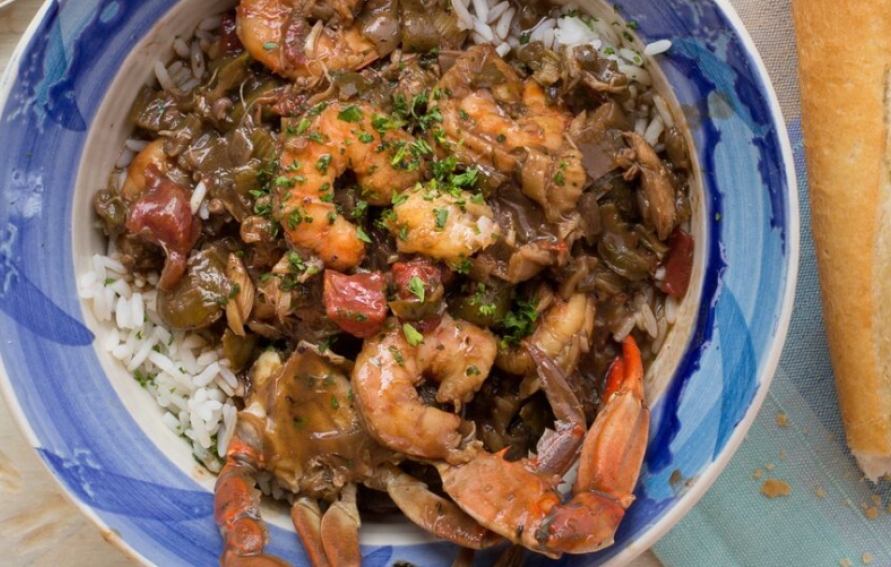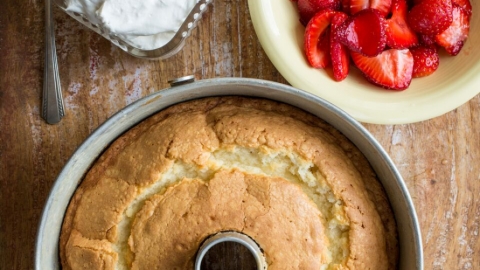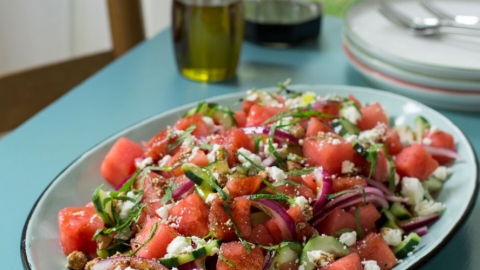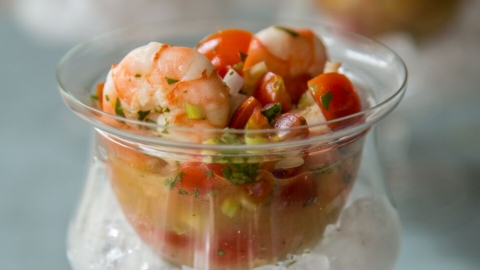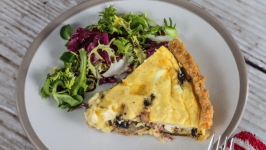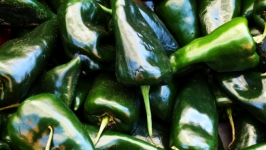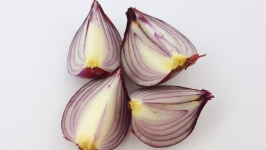Ingredients
- 3 lb. medium wild-caught Gulf shrimp, heads on
- 2 lb. cooked blue crab claw meat, picked through for shells, handled carefully to keep the meat in big chunks
- 4 large ripe tomatoes, or 1 (28-oz.) can whole tomatoes with their juices
- ¾ cup vegetable oil or bacon grease
- 1 cup all-purpose flour
- 2 large onions, coarsely chopped
- 1 bunch celery, coarsely chopped, including leaves
- 2 green bell peppers, coarsely chopped
- 8 cups shrimp or seafood stock (recipe follows), heated
- 2 to 3 tsp. sea salt, or to taste
- 1 Tbsp. freshly ground black pepper
- ¼ tsp. cayenne pepper
- 2 Tbsp. dried thyme
- 4 bay leaves
- 1 tsp. dried oregano
- 1 tsp. dried basil
- 2 Tbsp. LuLu’s Crazy Creola Seasoning (recipe follows), or other Creole seasoning
- ¼ cup hot sauce
- 2 Tbsp. Worcestershire sauce
- 4 blue crab bodies, if available (optional)
- 2½ lb. fresh okra, chopped into ¼-inch pieces, or thawed frozen cut okra
- 2 cups finely chopped green onions
- ½ cup finely chopped fresh parsley
- ½ cup fresh lemon juice
- Cooked white rice, for serving
- French bread and butter, for serving
- Heads, tails, and shells from about 5 pounds peeled wild-caught Gulf shrimp
- 6 qt. water
- 2 lemons, sliced into ¼-inch rounds
- 2 bay leaves
- 3 onions, coarsely chopped
- 6 celery stalks, coarsely chopped
- 1 bunch green onions, coarsely chopped
- Handful of fresh parsley with stems, washed thoroughly
- 1 tsp. whole black peppercorns
- 1 whole garlic clove
- white wine
- 1 Tbsp. sea salt
- 2 Tbsp. granulated garlic or garlic powder
- 4 tsp. granulated onion or onion powder
- ¼ cup paprika
- 1½ tsp. freshly ground black pepper
- 2 tsp. cayenne pepper
- 2 tsp. white pepper
- ½ tsp. dried thyme
- ½ tsp. dried oregano
Preparation
1. Peel and devein the shrimp. (If you’re making your own stock, reserve the heads and shells to make the stock.) Refrigerate the shrimp and crabmeat until ready to use.
2. If using fresh tomatoes, fill a medium saucepan with water. Bring to a boil. Carefully drop the tomatoes into the boiling water and cook for 1 minute. Remove with a slotted spoon and let them cool. The skins will slip off easily. Remove the cores and coarsely chop the tomatoes over a bowl to retain as much juice as possible. Set aside. (If using canned tomatoes, chop each tomato into eighths and return them to the juice in the can.)
3. To make the roux, in a large stockpot (about 10 quarts), heat the vegetable oil over medium-high heat. When the oil is hot, gradually add the flour, whisking continuously, and cook, stirring and adjusting the heat as necessary to keep it from burning, until the roux is a dark mahogany color, 25 to 35 minutes. Be careful: if the roux burns, you will have to start all over again!
4. Carefully add the onion to the roux and stir with a large wooden spoon for 2 to 3 minutes. (The onion will sizzle and steam when it hits the hot roux, so caution is advised. All seasoned gumbo cooks have roux battle scars on one or both arms.)
5. Add the celery and cook, stirring continuously, for 2 to 3 minutes.
6. Add the bell pepper and cook, stirring continuously, for 2 to 3 minutes more. The mixture should resemble a pot of black beans in color and texture.
7. Add the heated stock and the tomatoes with their juices. Stir in the salt, black pepper, cayenne, thyme, bay leaves, oregano, basil, Creole seasoning, hot sauce, and Worcestershire sauce. Stir well. Bring the gumbo to a boil and cook for 5 minutes, then reduce the heat to maintain a slow simmer. Add the crab bodies (if using) and simmer, uncovered, for about 1 hour.
8. Add the okra and bring the gumbo to a boil. Cook for 5 minutes. Reduce the heat to maintain a slow simmer and cook, uncovered, for 30 minutes, or until the okra has lost its bright green color and cooked down like the other vegetables. If the gumbo gets too thick, add a little water. If it is too thin, continue to simmer it, uncovered.
9. Gumbo is always better the day after it has been cooked, although I’ve never had a complaint when I served it the day I made it. At this point, you can cool the gumbo. Turn off the heat and let it sit for about 30 minutes. Then place the pot, uncovered, in an empty sink. Fill the sink with cold water and ice around the stockpot (try not to get any in the stockpot itself). Stir every 15 minutes to facilitate cooling. (The gumbo will spoil if improperly cooled—see page xxx for tips on cooling the gumbo.) When completely cool, refrigerate the gumbo in the stockpot, uncovered.
10. When ready to serve, slowly bring the gumbo to a simmer over medium-low heat. Thirty minutes before serving, add the green onion, parsley, and lemon juice to the gumbo. Cover and cook for 15 minutes. Add the shrimp and crabmeat, mix well, and cook for 2 minutes. Cover and turn off the heat. Let it sit for at least 15 minutes more to cook the seafood. The gumbo will stay hot for a long time. Remove and discard the bay leaves. Taste and adjust the seasonings; serve over cooked white rice with French bread and butter.
SHRIMP STOCK
If you are lucky enough to get shrimp with the heads on, rejoice. Shrimp heads make the stock even richer and more flavorful. When making stock, I fill an empty liter Coke bottle (label removed) with water and freeze it ahead of time. When the stock has cooled down a bit, about 30 minutes or so, I plunge the frozen bottle into the middle to help cool the stock from the inside out. This is also how I cool down a pot of gumbo before refrigerating it. Makes 4 quarts.
1. At least several hours before you plan to make the stock, fill a clean, empty 1-liter soda bottle with water to about 2 inches from the top, seal, and freeze it.
2. Run cold water over the shrimp shells to rinse. Place all the ingredients in a medium stockpot. Bring to a boil over high heat.
3. Reduce the heat to medium, or until the stock is simmering. Skim off the foam that rises to the top. Cook for a couple of hours, skimming again about every 15 minutes.
4. Place the stockpot in an empty sink. Fill the sink with water and ice around the stockpot. Let the stock cool completely, uncovered. When the stock has cooled down a bit, about 30 minutes or so, put the frozen soda bottle in the middle to cool the stock from the inside out. Strain the stock, discarding the solids, transfer to storage containers, and refrigerate or freeze immediately.
LULU'S CRAZY CREOLA SEASONING
Makes ½ cup.
Combine all the ingredients and store in an airtight container.
About this recipe
By Lucy Buffett
It takes courage to make a gumbo, and you’ve got to rustle up plenty more qualities along the way to achieve a successful end result. But like any character-building exercise, your experience and wisdom deepens with every step, until you reach a profound sense of satisfaction by the end of the process.
A simmering pot of contentment is your reward, and the knowledge that you made this nurturing goodness from the humblest of ingredients and your own ability. It is literally and figuratively a pot full of flavor that can feed your loved ones for days and that’s just brimming with all the courage, mindfulness, and love you put into it.
It all starts with preparation—you must gather all the ingredients and prep them: chop the vegetables, clean the seafood, and sauté the meats and sausages. When done in an orderly fashion, this preparation simplifies the steps to come. It eliminates the chaos and fear. With practice and focus, you quickly learn you were more afraid of the fear itself than the task at hand.
Next is the queen bee—the roux! Making a roux simply requires a little focus and paying attention, seasoned with faith—you have to shake off the doubt and believe in yourself before diving headfirst into the perseverance part, which keeps you doing what you have to do, stirring long after your arm has gone numb from pain. Then there’s the listening, where you tune in to your wisdom and experience to take the roux just to the edge of burning before you toss in the vegetables.
Next is the easy follow-directions part, where you do what you’re told to do: you add the stock, along with the rest of the ingredients and seasonings, and mix it all together. Then comes the hard part for lots of us: you let it go. You leave it alone, letting it simmer, with an occasional stir. You get out of the way. You trust the age-old cooking process and let the magic happen.
Photo by Angie Mosier. From Gumbo Love: Recipes for Gulf Coast Cooking, Entertaining, and Savoring the Good Life by Lucy Buffett (Grand Central Life & Style, 2017).

